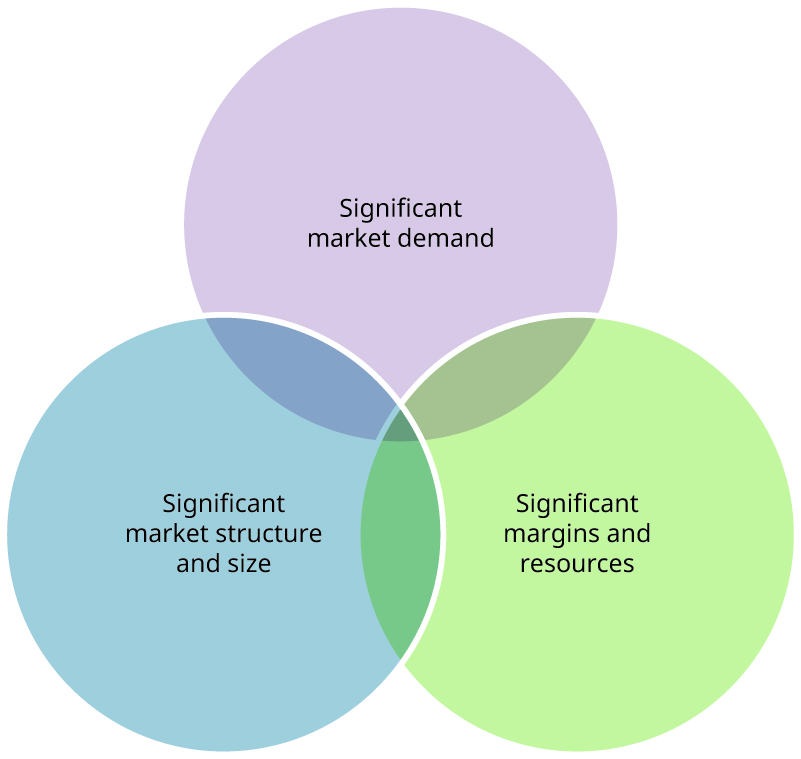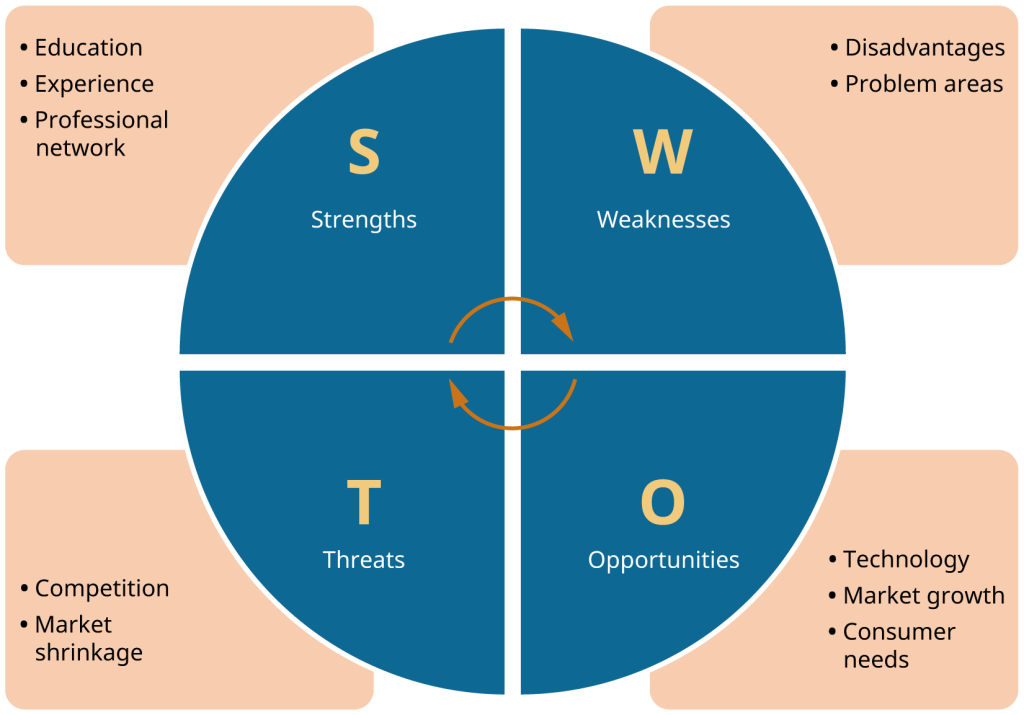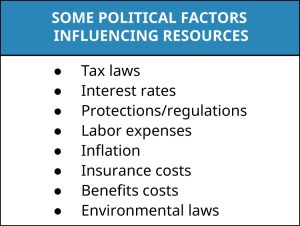Chapter 7 – Opportunity Analysis
Learning Objectives
- Determine when an idea becomes a recognized opportunity
- Create a SWOT analysis for an entrepreneurial venture
- Conduct a PEST analysis
- Develop a Business Model Canvas based on the nine building blocks
recognizing and Verifying the Entrepreneurial Opportunity
Whether you start your own business, buy an existing business, or purchase a franchise, researching the industry, your target market, and examining the economic and funding options are all part of performing due diligence. Due diligence is the process of taking reasonable steps to verify that your decisions are based on well-researched and accurate information. It means thoroughly researching potential pursuits, asking detailed questions, and verifying information.
One of the more common questions entrepreneurs must ask is whether now is a good time to start a business. This question of timing is addressed in the investigation to determine whether the idea is merely interesting or fits the criteria of being an entrepreneurial opportunity.
An idea can move to a recognized opportunity when the following criteria are met. The figure below shows these three factors:
- Significant market demand
- Significant market structure and size
- Significant margins and resources to support the venture’s success

Significant market demand means that the idea has value by providing a solution to a problem that the target market is willing to purchase. This value can result from a new product or service that fills an unmet need, a lower price, improved benefits, or greater financial or emotional value. This value can also result from capitalizing on “nonconsumption.” For example, in the 1980s, the Disney Corporation realized that it was losing an opportunity to entice visitors to come to their theme parks from 9 p.m. to 9 a.m. when they were closed. So the company started having “school nights” when schools and students could use the parks at a discount.
Significant market structure and size involve growth potential and drivers of demand for the product or service. Barriers to entry are manageable, meaning that entering the industry or creating a new industry is not exceptionally difficult. If the industry already exists, there must be room within the industry for your venture to gain market share by providing a value that creates a competitive advantage.
Significant margins and resources involve the potential for achieving profit margins at a high-enough level that the work of starting the venture (including the entrepreneur’s time and energy) is worth the risks involved. If the operating costs are too high and the profit margin is too low, it is important to analyze whether the idea is truly feasible. Significant margins also include the capital requirements—how much money is needed to start the venture—as well as the technical requirements, the complexity of the distribution system, and similar resources. Determining whether an idea has significant market demand, significant market structure and size, and significant margins and resources to support the venture’s success represents the most basic concerns when screening a business idea as an entrepreneurial opportunity.
Using SWOT Analysis to Evaluate Entrepreneurial Opportunity
One way to evaluate a business idea is to prepare a SWOT analysis (see figure below). You may be familiar with a SWOT analysis from other classes through analyzing an organization’s strengths, weaknesses, opportunities, and threats. However, a SWOT analysis for a new business venture differs slightly because we are not only looking at the organization, we are also looking at the entrepreneur who will run the organization. Note that strengths and weaknesses are internal to the entrepreneur, while opportunities and threats are external factors. Strengths are capabilities and advantages of the entrepreneur, including education, experience, and personal or professional contacts. Weaknesses are disadvantages of the entrepreneur, which could include lack of knowledge or experience. Opportunities are positive events that the entrepreneur can develop to their benefit. This could include development of new technologies, changes in consumer tastes and preferences, market growth, and new laws and regulations. Threats can be anything that could potentially harm the business or prevent the business from becoming successful such as competition, negative changes in economic conditions, and new laws or regulations.

PEST Framework
Another tool that can be used to analyze opportunities and threats mentioned in the previous section is called PEST analysis (political, economic, sociocultural, technological). In this analysis, we identify issues in each of these categories. The PEST framework is a strategic assessment tool that entrepreneurs can use to identify factors that may influence access to essential resources (See Figure 7.3).
Political Factors
Although you may hope to be your own boss, make your own schedule, and follow your own rules, you must still work within the realities of outside factors that affect your business. Political factors stem from changes in politics, such as the policies of a new presidential administration or congressional legislation. Such policies can affect access to capital, labor laws, and environmental regulations. Moreover, these political changes can take place on federal, state, and local levels. The figure below lists several political factors that can influence a business. Tax reform law, for example, could influence the amount of taxes a business owes, while actions by the newly appointed chair of the Federal Reserve could affect how much capital may cost the small business owner because of interest rate changes.

Businesses must also follow environmental laws, such as those from the Occupational Safety and Hazard Association and the Environmental Protection Agency (EPA). For example, these government agencies require businesses to train employees about materials that may be hazardous to people and provide notices and reports on these matters. The EPA also has regulations on air and water emissions that businesses must follow, as improper disposals can harm the environment. Smaller businesses may be exempt from some of the regulations under certain circumstances.
Imported products are regulated by the federal government through quotas and tariffs. Tariff laws have been used as political instruments to manage the flow of goods between countries. Tariffs are taxes or duties that are added to imported goods from another nation. Quotas, a limit on the number of items entering a country, are also used to restrict the volume of goods entering a country. For example, the US government in 2018 imposed tariffs on $550 billion of Chinese products, while China has imposed tariffs on $185 billion worth of US products. As of 2024, the White House has proposed a 100% tariff on all electric vehicles made in China. Free trade remains an ongoing source of international economic competition. As an entrepreneur, you should remain aware of political issues that may impact your operations and planning.
Economic Factors
Entrepreneurship has a direct impact on the economy by providing employment opportunities to many people. However, economic factors can also affect the success of a business. For example, they can deter customers from purchasing goods and services due to an economic downturn. On the other hand, when the economy is expanding and growing, people tend to feel confident about their jobs and income, and they may spend more than usual. Economic factors—which include inflation rates, interest, currency exchange (if the business operates or engages globally), state of the economy (growth or decline), employment rates, and disposable income—can impact the business owner’s pricing of goods or services, the demand for such services, and the cost of production.
Taking the state of the economy, for example, when the economy is down, restaurants will see a decline in clientele as more people prepare meals at home to save money, or they will switch from fine dining restaurants to more casual or fast-food restaurants. In weak economies, consumers tend to purchase store (often called “private label”) brands more often than national brands to reduce their grocery bill. When the economy is healthy, consumers spend more on entertainment and restaurants, which can be considered luxury items. The restaurant will need to adjust its resources to meet the economy-driven fluctuating demand. When demand is high, it is likely that the restaurant will need more supplies and more employees. These needs, in turn, result in the restaurant needing additional financial resources to buy more supplies and to pay employees. When demand is low, the opposite is true.
Sociocultural Factors
Knowing about your customers is key to delivering what they really want. Additional factors that need to be taken into consideration include changes in how society is moving and the direction of that movement as it relates to your customer base and potential new markets. These sociocultural factors include population growth rates, changes in where people live, social trends such as eating healthier and exercising, education levels, generational trends (baby boomer, Gen X, millennial, or Gen Z), and religious culture. It is necessary to look at these factors closely in order to assess if the opportunity you are pursuing has a market large enough to support it.
One far-reaching sociocultural factor is the impact that digital shopping has had on brick-and-mortar retailers. This online shopping trend has forced long-established companies such as JCPenney, Payless, Gap, Victoria’s Secret, Radio Shack, Macy’s, and Sears, to close thousands of stores, file for bankruptcy, or shut down the business altogether. These companies have faced enormous competition from entities such as Amazon and smaller businesses such as ModCloth and Birchbox that interact with customers virtually and stay on top of societal trends. Younger generations such as the millennial and Z generations have triggered these social changes, as they are technologically savvier and expect to find exactly what they want, where they want it, and when they want it.
Technological Factors
In the case of technological factors, the enterprise needs to be sure it has equipment that allows it to operate efficiently. There are different types of technology that help with marketing, finances, productivity, collaboration, design, and production. The drawback is that some of these technologies can be expensive to purchase, and it can take a long time to recuperate the cost. Entrepreneurs must be sure to acquire only those tools and materials that will help them get started. Then, as the business thrives, more funding is available for more expensive equipment and software.
Business Model Canvas
Once an entrepreneur has conducted an opportunity analysis and feels strongly about moving forward with an idea, the next step is to create a business model. A business model is a plan for how venture will be funded; how the venture creates value for its stakeholders, including customers; how the venture’s offerings are made and distributed to the end users; and the how income will be generated through this process. The business model refers more to the design of the business, whereas a business plan is a planning document used for operations.
Each business model is unique to the company it describes. A typical business model addresses the desirability, feasibility, and viability of a company, product, or service. At a bare minimum, a business model needs to address revenue streams (e.g., a revenue model), a value proposition, and customer segments. In non-jargon English, this means you want to address what your idea is, who will use it, why they will use it, and how you will make money off it.
A canvas is a display that would-be entrepreneurs commonly use to map out and plan different components of their business models. There are several different types of canvases, with the business model canvas and the lean canvas being the most commonly used.
As developed by Osterwalder and Pigneur, the business model canvas has nine components, as shown in the figure below.
- Customer segments
- For whom are we creating value?
- Who are our most important customers?
- Mass market; niche market; segmented; diversified; multi-sided platform.
- Value propositions
- What value do we deliver to the customer?
- Which one of our customer’s problems are we helping to solve?
- What bundles of products and services are we offering to each customer segment?
- Which customer needs are we satisfying?
- Characteristics: newness; performance; customization; “getting the job done”; design; brand/status; price; cost reduction; risk reduction; accessibility; convenience/usability
- Channels
- Through which channels do our customer segments want to be reached?
- How are we reaching them now?
- How are our channels integrated?
- Which ones work best?
- Which ones are most cost-efficient?
- How are we integrating them with customer routines?
- Customer relationships
- What type of relationship does each of our customer segments expect us to establish and maintain with them?
- Which ones have we established?
- How are they integrated with the rest of our business model?
- How costly are they?
- Examples: personal assistance; dedicated personal assistance; self-service; automated services; communities; co-creation
- Revenue streams
- For what value are our customers really willing to pay?
- For what do they currently pay?
- How are they currently paying?
- How would they prefer to pay?
- How much does each revenue stream contribute to overall revenues?
- Types: asset sale; usage fee; subscription fees; lending/renting/leasing; licensing; brokerage fees; advertising
- Fixed pricing: list price; product feature dependent; customer segment dependent; volume dependent
- Dynamic pricing: negotiation (bargaining); yield management; real-time-market
- Key resources
- What key resources do our value propositions require?
- Our distribution channels?
- Customer relationships?
- Revenue streams?
- Types of resources: physical; intellectual (brand patents, copyrights, data); human; financial
- Key partners
- Who are our key partners?
- Who are our key suppliers?
- Which key resources are we acquiring from partners?
- Which key activities do partners perform?
- Motivations for partnerships: optimization and economy; reduction of risk and uncertainty; acquisition of particular resources and activities
- Key activities
- What key activities do our value propositions require?
- Our distribution channels?
- Customer relationships?
- Revenue streams?
- Categories: production; problem-solving; platform/network
- Cost structure
- What are the most important costs inherent in our business model?
- Which key resources are most expensive?
- Which key activities are most expensive?
- Is your business more: cost driven (leanest cost structure, low price value proposition, maximum automation, extensive outsourcing); value driven (focused on value creation, premium value proposition).
- Sample characteristics: fixed costs (salaries, rents, utilities); variable costs; economies of scale; economies of scope
According to Osterwalder, et al. (2010), the things we typically teach people in business school are geared to helping people survive in larger, ongoing businesses. What is taught—including organizational structures, reporting lines, managing sales teams, advertising, and similar topics—is not designed to help students understand how a start-up works and how to deal with the volatile nature of new ventures. The Business Model Canvas idea is meant to help us understand start-ups.
The Business Model Canvas tool is intended to be applied when business operations can be started on a small scale and adjustments can continually be made until the evolving business model ends up working in real life. This is in contrast to the more traditional approach of pre-planning everything and then going through the set-up and start-up processes and ending up with a business venture that opens for business one day without having proven at all that the business model it is founded upon will even work. These traditional start-ups sometimes flounder along as the owners find that their plans are not quite working out and they try to make adjustments on the fly. It can be difficult to make adjustments at this time because the processes are already set up. For example, sales teams might be in the field trying to make sales and blaming the product developers for the difficulty they are having, and the product developers might be blaming the sales teams for not being able to sell the product properly. The real issue might be that the company simply isn’t meeting customers’ needs and they don’t have any good mechanism for detecting and understanding and fixing this problem.
Project Focus
Now that you have completed the ideation phase, it’s time to select one of your ideas to move forward with in your project. Consider the opportunity analysis components as well as the PEST analysis. Is there a market for your product? Can you make money from it? What barriers do you foresee?
Start creating a rough draft of your Business Model Canvas.
Attribution
This work builds upon materials originally developed by the following:
OpenStax in their publication “Entrepreneurship,” which is licensed under CC BY 4.0.
Lee Swanson in their publication “Entrepreneurship” and Innovation Toolkit” which is licensed under CC BY-SA 4.0
the process of taking reasonable steps to verify that your decisions are based on well-researched and accurate information
a plan for how venture will be funded; how the venture creates value for its stakeholders, including customers; how the venture’s offerings are made and distributed to the end users; and the how income will be generated through this process

